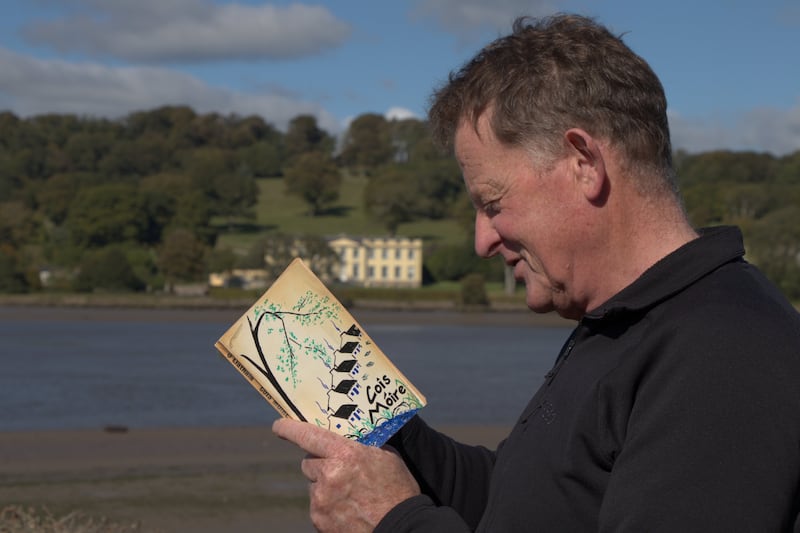“It’s like Ireland’s Bayeux Tapestry – all Irish history from the Neolithic Age to modern times is there,” said Diarmuid Ó Drisceoil, contemplating his first-time venture into TV presenting and his exploration of the Munster Blackwater.
Following in the footsteps of Irish-language activist Annraoi Ó Liatháin’s travel classic Cois Móire, the author followed the river from its source in Kerry through Cork and into Waterford before entering the sea at Youghal in a series of the same name.
“Annraoi was from Glendine near Youghal and his father was the gamekeeper at Ballinatray House so he grew up there and that’s where he fell in love with fishing and the river – he joined the Civil Service and was very involved in Irish-language circles and was very republican in his thinking.
“He wrote a book about fishing in Ireland, and he wrote books about the Blackwater and the Suir as well as a couple of novels, all as Gaeilge, but his book about the Blackwater, which was published in 1964 is regarded as a classic of Irish language travel classic and I use that as my guide, as it were.”
Actor Armie Hammer resurfaces as host of celebrity podcast
Heart-stopping Halloween terror: 13 of cinema’s greatest jump scares
Doctor Odyssey’s core message: just imagine Pacey from Dawson’s Creek holding you tight and saying, ‘Shhh, it’s okay’
Conor Niland’s The Racket nominated for William Hill Sports Book of the Year
Unlike Ó Liatháin, who walked along the banks of the Blackwater, Ó Drisceoil took to the river itself, paddling his own canoe for all but the first ten kilometres from its source on the Kerry side of the Mullaghareirk Mountains and journeying by boat the remainder of its 169 kilometres to Youghal.
En route, he passed landmarks including stately homes such as Ballymacoy House, ancestral home of the Hennessy family of Cognac fame, Renny, where Edmund Spenser lived, and Ilecash House, where British fascist Oswald Mosley stayed.
“I speak to lots of interesting people along the way, like Donal Hickey, formerly of The Irish Examiner, about growing up in Knocknagree, and Con Houlihan, who owns Duarigle Castle, and we look at Nora Herlihy from Ballydesmond who founded the Irish Credit Union movement,” he said.
“At Clonbanin, I hear the story of the famous ambush in March 1921 when the IRA under Sean Moylan attacked a British army convoy and the British general Hanway Robert Cumming shouted ‘To Hell with Surrender – give them the lead’ just before he was shot dead along with 12 of his men.”
Past Banteer, Ó Drisceoil heard the story of 17th century rapparee, Donal A’ Rasca, a descendant of the O’Keeffes of Dromagh Castle, who was betrayed to the British by his lover, Mairead Ní Cheallaigh
“When Donal met Mairead in his hideout at Gortmore Cave, he hugged her and he felt something under her chemise and he found a document given to her by the British, promising her all sorts. He knew he was betrayed, and he stabbed her to death – it’s a tragic story but the cave is amazing.”
Further downstream, Ó Drisceoil met Máire Ní Bhriain, who told him about how Mallow developed as a Spa town, styling itself on Bath in England.

On the home straight, Ó Drisceoil headed for Youghal where the Blackwater enters the sea, encountering links with Sir Walter Raleigh and Richard Boyle, and Ireland’s longest boardwalk at Claycastle.
“The Blackwater is an extraordinary river, so rich in history and lore and stories – I know it’s been called Ireland’s Rhine which probably stems from the Cappoquin to Youghal section because you have these wooded hills and these big striking castles on prominent points,” said Ó Drisceoil.
“But Annraoi Ó Liatháin took an exception to that analogy, and he says that it’s part of our inferiority complex here in Ireland and he says it’s the Germans who should be describing the Rhine as ‘The Blackwater of Germany’, not vice versa.
“All of Ireland’s history is there and when you look at the archaeology, you can talk about the native Irish, the Vikings, the Normans, the Munster Plantation, you have abbeys, and castles and big houses – it’s fascinating and I enjoyed the journey so much. Hopefully that comes across in the series.”
Cois Moire, made by Cormorant Films with support from Cork County Council, begins on TG4 on Wednesday November 9th at 9.30pm.




